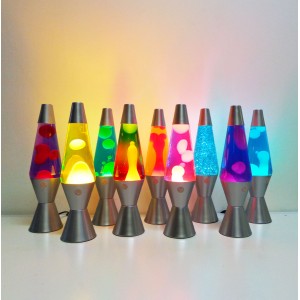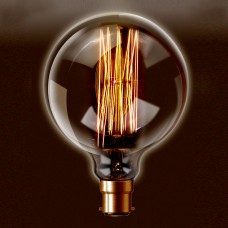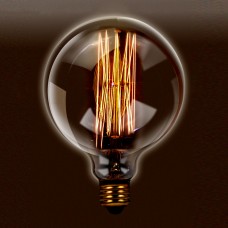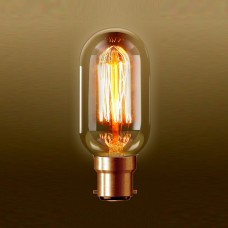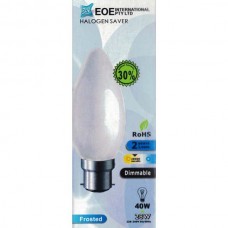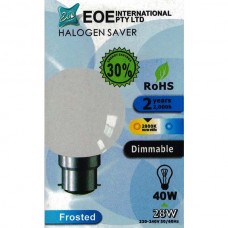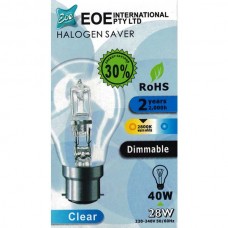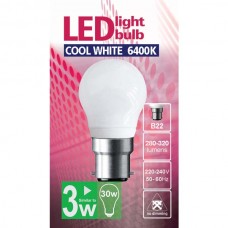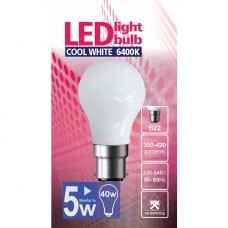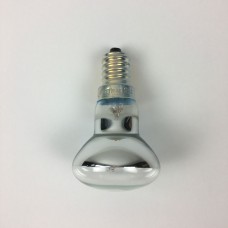Globes & Bulbs
Despite Thomas Edison not inventing the first light bulb, he did invent the first household light bulb. There is a small rumor that he was afraid of the dark. Thanks to Thomas Edison, everyone today is able to continue their daily tasks into the night without a problem.
INCANDESCENT LIGHTS
Incandescent lights use a specialized resistor that slows down the electricity that flows through it. Some of the electrical energy is given off as light, but a lot is given off as heat, which is why these bulbs are not as efficient. The bulb must be air tight so the resistor filament does not burn out.
Incandescent light tends to be a warm white color, mostly because its light wavelengths pass beyond the visible spectrum and include many infrared wavelengths. This range, including red visible and invisible light, gives it a more natural color.
HALOGEN
Halogen bulbs are a more efficient version of the incandescent bulb. These bulbs emit very bright white light. Their light output will not diminish as the bulb ages. Halogen bulbs are also known for their consistent ability to start up with no flickering.
FLUORESCENT LIGHTS
Fluorescent lights use a special inert gas and a powder coating on the inside of their bulbs to produce lights. The electrical current cycles through the gas and excites its atoms. After each cycle the atoms release their energy in small bursts, which then hit the atoms of the powder coating. The coating atoms react in the same way, but the energy they release is actually light. This process uses electricity very efficiently.
Fluorescent lights tend to be white or bluish, but their color depends on the temperature of the light produced, with light around 6500 Kelvin produced wavelengths across the spectrum in a way similar to daylight.
LED LIGHTS
Light-emitting-diode, or LED, bulbs are long-lasting and extremely energy-efficient. LEDs use a semiconductor as their light source, and the amount of light given off is measured in lumens. Incandescent bulbs are categorized by their wattage, but wattage does not measure brightness; it only indicates how much electricity a bulb uses. LED lighting has many applications and may replace other types of lighting in the future. Battery-operated LED lanterns or flashlights have several advantages over other types of lighting, such as incandescent bulbs. Widespread use of LED lighting, however, may require a reduction in cost.
COMPARISON
Incandescent light bulbs fade with age, unlike halogen bulbs. An average incandescent bulb will last anywhere between 750 and 1,000 hours. An average halogen bulb will last anywhere between 2,250 and 3,500 hours. A 75 watt incandescent bulb produces around 1,180 lumens of light while a 75 watt halogen bulb lets off about 1,300 lumens. Both incandescent and halogen light bulbs are available in a variety of sizes and voltages.
LED bulbs are expensive, costing more than 10 times the price of equivalent incandescent bulbs. Because LED bulbs use less energy and last longer, however, they save money compared to incandescent or compact fluorescent bulbs in the long run. Energy Star-designated LEDs are a good investment, and prices for LEDs are expected to come down in the future, encouraging more LED bulb use.
USES
Standard incandescent light bulbs are great for everyday use in the home where “soft” light is desired. Some incandescent light bulbs are used not only for their light output but for their heat output as well. Heat lamps found in reptile tanks utilize the heat producing capabilities of incandescent bulbs to warm small, contained environments. Halogen bulbs keep a constant light output throughout their lives which is one of the reasons why they are widely used in car headlights. This type of bulb is ideal for outdoor situations like lighting up a deck or patio. Halogen lights can also be used in the home where intense light is desired.
MORE EFFICIENT AT LOWER BRIGHTNESS
While there is no simple conversion formula, LED bulbs tend to be more energy efficient than incandescent bulbs at lower levels of brightness than they are at higher levels of brightness. For example, to produce 450 lumens, an LED bulb needs 4 or 5 watts and an incandescent bulb requires 10 times as much energy -- 40 watts. Yet to produce 2,600 to 2,800 lumens, an LED bulb needs 25 to 28 watts and an incandescent bulb requires about six times more energy --150 watts.
How to Compare LED Light Output to Incandescent Bulbs
Changing a light bulb is one of the simplest steps most households can take to save energy. According to Energy Star, if each household changed just one bulb, the reduction in greenhouse gas emissions would be the equivalent of taking 2 million cars off the road. Light-emitting diodes are one of the many energy-saving alternative lights now available. Although expensive, these bulbs save you money by lasting up to 20 years and using only a fraction of the energy that an incandescent light does. Shopping for LEDs can be confusing until you learn how to compare their light output compared to other bulbs.
Understand what is meant by lumens. Traditional bulbs are measured in watts, but because LEDs use so little energy, wattage is not an indication of brightness. Lumens are a measure of brightness and are now stated on most packages of bulbs.
Determine the wattage on your current bulbs. Before you purchase LEDs to replace your incandescent bulbs, you'll need to know the wattage of your old bulbs. This number is printed either on the top of the bulb or along the base of the bulb.
Convert your old bulb's wattage into lumens. This can be calculated if you happen to know your bulb's lumens per watt, using this equation: Lumens = Watts x lumens per watt. However, because lumens per watt vary for both incandescent and LED lights, it's easier to use a wattage-to-lumens comparison chart. Since most household bulbs are 40W, 60W, 75W or 100W, you may be able to memorize their equivalent lumens. Some of the common wattages vs. lumens for incandescent bulbs are: 40W equals 450 lumens, 60W equals 800 lumens, 75W equals 1100 lumens and 100W equals 1600 lumens.
Examine the label of the LED bulbs at the store. Bulb packaging now has a Lighting Facts label to inform you about the bulb's lumens, wattage used, lifespan and cost to operate. Lumens are listed under Brightness. Find a bulb that matches the lumens you need to replace your incandescent bulbs.
Tip
Most incandescent bulbs emit a warm, yellow light, while most LEDs produce a white light. If this is a concern, check the Lighting Facts label for the Light Appearance information.
Look for Energy Star approved LEDs. These lights produce a high-quality light over their lifetime and are more reliable than nonapproved LEDs.
Warning
Never exceed the maximum wattage stated on your light fixture.
Refine Search
T64-145
Edison Carbon Filament Bulb 40WEdison Car..
T125-168B
Edison Carbon Filament Bulb 60W B22Edison Car..
T125-168E
Edison Carbon Filament Bulb 60W E27Edison Car..
T45-110
Edison Carbon Filament TubularEdison Car..
T30-185
Edison Carbon Filament Tubular longEdison Car..
RL211
Halogen Bulb Candle Clear 28w B22/E2...Halogen Bu..
RL212
Halogen Bulb Candle FrostedHalogen Bu..
RL221
Halogen Bulb Fancy Round ClearHalogen Bu..
RL222
Halogen Bulb Fancy Round FrostedHalogen Bu..
RL231
Halogen Bulb GLS ClearHalogen Bu..
RL232
Halogen Bulb GLS FrostedHalogen Bu..
RL5601
LED Filament Bulb 8W Warm LightLED Filame..
RL4452W3
LED Light Bulb 3WLED Light ..
RL4552W5
LED Light Bulb 5WLED Light ..
RL4652W7
LED Light Bulb 7WLED Light ..
RL39-30W
Spare Reflector Light Bulb for Lava ...Spare Refl..



